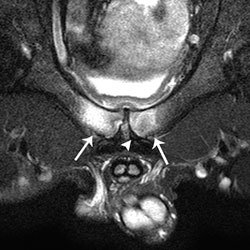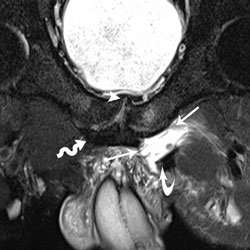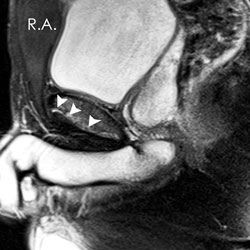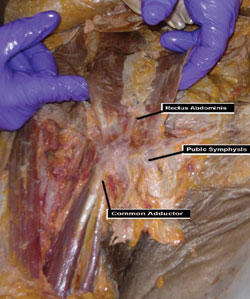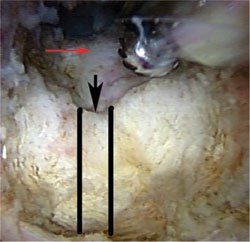Athletic pubalgia: Current concepts and evolving management
Introduction
A few years back, an athletic woman was referred to me because of symptomatic femoroacetabular impingement (FAI) in both hips and central groin pain from refractory osteitis pubis that began during her first pregnancy. She underwent an endoscopic pubic symphysectomy/curettage as part of a comprehensive single-stage minimally invasive surgery that also included bilateral arthroscopic surgeries for FAI. Since then, I’ve been hearing more about athletic pubalgia and, no doubt because of increasing awareness, I’m seeing this condition in my practice with commensurately increasing frequency. Often this is in patients with FAI.
In hopes of expanding our understanding, I’ve invited some clinical thought-leaders to this month’s Round Table for an open discussion of an arguably timely topic.
— Dean K. Matsuda, MD
Moderator
|
||||||
Dean K. Matsuda, MD: I have heard athletic pubalgia (AP) termed a “wastebasket” diagnosis encompassing many diverse conditions. I’m not saying I agree with that, but what exactly is AP?
William C. Meyers, MD: Athletic pubalgia is an umbrella term for career ending, or quality-of-life-threatening, musculoskeletal injuries involving attachments and/or soft tissue support structures of the pubis. Terms such as “sportsman’s hernia” mislead the lay and medical communities into thinking these problems are occult hernias. I see many patients each week who have had unsuccessful hernia surgery for these injuries. We discourage that term since it leads to difficulty in accurately diagnosing and successfully treating the injuries.
These are real injuries within complex anatomy. There are more muscles, ligaments, bones and other soft tissues in the pelvis than anywhere else. There are a lot of systems to consider including gynecologic, genitourinary, gastrointestinal and neurologic. Nerves and soft tissues are packed in close proximity, and there is a prevalence of referred pain that makes diagnoses particularly difficult. Plus, the hip is imbedded as the deepest joint in the body. One should think in terms of the pubic bone as another joint (the pubic joint) with many attachments and that the hip and pubic joints work closely together in maintaining pelvic stability.
If you dissect a fresh cadaver and cut the rectus abdominis attachment to the pubis, you get profound changes in pressure in the adductor region. These changes are what led us to look at this anatomy more closely. One way to simplify the functional anatomy in this region is to compare the pubic “joint” to the knee: the central attachments (eg, rectus abdominis and three adductors for the pubis; cruciate ligaments for the knee) are most important for stability. The more lateral structures crossing the joint (eg, psoas, rectus femoris, sartorius for the pubis; collateral ligaments for the knee) provide important support, but are not as important for stability and heal quicker — often without surgery. This analogy grossly simplifies the pathophysiology but can help visualize these injuries. The symphyses themselves and symphyseal joint do get involved, but rarely as the primary problem. They get involved usually in a reactive way (ie, a “secondary” osteitis pubis) possibly from cartilage plate tears and tiny avulsion fractures rubbing the wrong way.
True hernias, of course, do occur in this relatively young population, and it is really important to emphasize that they are almost always coincidental and do not cause the exertional pain experienced by the patients.
Matsuda: With so many different conditions, is there anything besides anatomic region that ties these together?
Meyers: Function and pathophysiology tie the anatomy and the AP conditions together. Here are several factors:
- These conditions involve the same anatomic region and many structures are actually attached to each other, such as the rectus abdominis and the three most important adductors: pectineus, adductor longus and brevis.
- The forces often compete and involve several opposing directions: side-to-side, superior-inferior, anterior-posterior, and obliquely or in rotational pathways.
- The patients usually complain of pain in several different locations and involving different soft tissue or skeletal structures.
- The hip and soft tissue structures outside the hip are intimately related not only in proximity, but also in terms of overlapping pathology and pain referral patterns. One injury can lead to another. In fact, about 10 to 15% of the time (the percentage varies according to sport, gender and several other factors), the patients come in with simultaneous hip and AP problems.
- The concept of the “pubic joint” described previously ties the aforementioned observations together.
- Often, the patients won’t get better unless the multiple sites of pain are addressed surgically.
- I spend a great deal of each week re-operating on patients who have had unsuccessful or transiently successful hernia operations for their pains.
- One needs to keep in mind that persistent or recurrent pain after a hernia (or other) operation can also come from other sources such as the hip, non-musculoskeletal causes or synthetic mesh.
Matsuda: We’re hearing a lot about athletes with FAI. How common is AP seen in these athletes and is there some connection?
Christopher M. Larson, MD: The true prevalence or incidence of associated FAI and AP in athletes is not well defined at this point. We are, however, seeing an increase in the number of athletes with this association. Several recent studies also support this observation. Feeley and coworkers found an association between hip labral tears, rectus abdominis tears, and adductor strains in NFL players and coined this the “Sports Hip Triad.” Verrall and coworkers published two compelling articles that show a strong association between hip joint range of motion limitations and the development of chronic groin pain and osteitis pubis in Australian League Football Players. Another article by Weir and colleagues found that 94% of athletes who presented with long-standing proximal adductor pain had radiographic evidence for FAI. It is clear that both hip joint disorders and AP often present independent of each other in athletes. I believe, however, that when athletes present with both FAI and AP, there is a biomechanical basis behind this association. FAI typically presents with limitations in hip range of motion which can lead to increased stresses and subsequent compensatory patterns involving the abdominal obliques, distal rectus abdominis, pubic symphysis, and adductor musculature during athletic activity. I think it is these compensatory patterns that can lead to athletic pubalgia and other extra-articular hip related symptoms in this particular setting.
|
Image: Larson CM |
Associated AP with rectus abdominis involvement, as mentioned by Dr. Meyers, can lead to a relative anterior pelvic tilt/ instability which can further aggravate the intra-articular hip symptoms.
Matsuda: With so many separate, albeit related conditions, how does one perform a physical examination for AP?
Meyers: It is important to consider both history and physical examination. Histories should be conducted with careful attention to three sets of diagnoses: AP; hip; and other causes. Because AP results primarily from muscular disruption, the pain of AP is primarily exertional in nature and predictable with initiation of forceful activities such as sprinting and changes of direction. The pain may also affect normal activities such as coughing, sneezing or rolling over in bed at night. The pain may vary from side to side, depending on patterns of compensation, and involve multiple sites of soft tissue attachments such as the rectus abdominis and specific adductor muscles. The inflammatory response associated with the osteitis pubis that sometimes accompanies AP may cause tenderness and pain particularly after cessation of activities.
In contrast, patients with hip problems usually describe pain with or after minimal activity such as prolonged standing, walking or jogging, or with certain postures such as prolonged sitting, or going up and down stairs or lunging. The pain is often more sporadic and less predictable. Pain from other causes often has historical clues such as genitourinary, gastrointestinal, back, gynecological symptoms or past problems, or continuous or sporadic pain totally unrelated to physical activity. Some patients who have other causes also may have benign musculoskeletal injuries at the same time, sometimes making accurate diagnosis perilous.
Physical examinations should be conducted with careful attention to the same three categories of diagnoses. For AP, we have developed resistance tests for each of the muscles attaching to or crossing the pubic symphysis or joint (see Table). These tests involve resistance against the primary action of each muscle. Interpretation of each test involves three considerations: Does the test cause pain? Does the resultant pain correlate to the muscle being tested? and Does the resultant pain re-create the pain causing the athlete’s disability? For the hip problems, the examination involves primarily range-of-motion tests without interference from contraction of muscles. These include the standard FABER (flexion, abduction, external rotation) and FADIR (hip flexion, adduction, internal rotation) tests, plus numerous other rotational or hyperflexion or hyperextension tests that could isolate anterior, posterior or lateral impingements or other pathology. Localized tenderness, of course, is sometimes helpful for specific diagnoses, although the tenderness associated with various types of bony or soft tissue inflammation also can be confusing. Extreme pain with light touch may also be a clue to the existence of CRPS (chronic regional pain syndrome)/RSD (reflex sympathetic dystrophy). Comprehensive physical examinations, sometimes with internal pelvic or rectal examinations, may be extremely important to detect the non-musculoskeletal diagnoses.
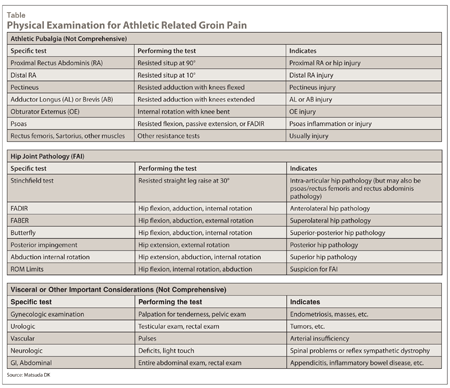
Larson: I agree that a thorough physical examination is required to accurately diagnose athletes with athletic related groin pain. It is imperative to have an understanding and ability to perform a physical examination for both intra-articular and extra-articular causes for athletic-related groin pain (Table). Dr Meyers nicely outlined the examination for AP. Because of the association between AP and FAI in some athletes, it is critical to evaluate for any underlying hip joint related pain. Although multiple tests are described and useful, I find that groin or deep lateral hip pain elicited with the FADIR test, FABER test, Butterfly test (flexion, abduction, internal rotation) and lateral impingement test (abduction, extension, internal rotation) indicate possible underlying hip joint pathology. In addition, limitations in hip forward flexion, internal rotation, and abduction range of motion may be indicative of underlying FAI. I also rely heavily on diagnostic injections to try and piece the overall picture together. Relief, or lack thereof, with an anesthetic injection followed by an examination and or exercise challenge helps to rule in or out the potential pain generators. I often use pubic symphyseal or pubic cleft, adductor peritendinous, psoas bursal, and intra-articular hip anesthetic injections to confirm the respective areas contributing to the overall picture.
Matsuda: So now that we’ve narrowed down the diagnosis, what imaging studies for which conditions make the most sense?
|
Image: Zoga A |
Adam Zoga, MD: Musculoskeletal lesions at or near the pubic symphysis and internal derangements of the hip are the two most common lesions encountered by a musculoskeletal radiologist in the assessment of groin pain in the active patient. When either of these is suspected, an MRI with a protocol tailored to the particular lesion is the imaging study of choice. However, at my institution, the first three sequences acquired with either a noncontrast AP MR protocol or a direct MR arthrogram of the hip are identical, covering the entire musculoskeletal pelvis. Therefore, targeting either of these lesions with a dedicated MRI does not necessarily mean that the other will be entirely overlooked. Often, subchondral changes at the acetabulum are observed on a dedicated AP MRI, indicating cartilage loss and likely a labral tear at the hip. Similarly, bone marrow edema at the pubic symphysis is encountered with some frequency on direct MR arthrographic hip studies, indicating an AP lesion that may be the source of groin pain, or may coincide with a concomitant hip lesion.
Allowing for this, a noncontrast MRI utilizing a dedicated AP protocol is indicated with suspected osteitis pubis, rectus abdominis or adductor tendon lesion, and even in the setting of a true groin hernia. This protocol does not require any specialized MR equipment or excessive time, but effective imaging plane and sequence selection is essential. In 2011, a dedicated AP protocol should be available at most quality imaging centers with 1.5 or 3 Tesla MR scanners. Unfortunately, the level of quality at privately owned MRI centers still varies considerably, so it is best to insure that your radiologist and/or technologist are at least aware of a such a dedicated AP protocol before finalizing the referral.
Optimal imaging of internal derangements of the hip is a bit more difficult and labor intensive, as noncontrast hip protocols, regardless of the equipment, are relatively insensitive for acetabular labrum tears and articular cartilage lesions. The study of choice is a direct MR arthrogram, where high-resolution arthrographic sequences dedicated to the hip are acquired after a fluoroscopy- or ultrasound-guided intra-articular injection of gadolinium-based contrast material diluted in saline. In conjunction with the contrast injection, we place anesthetic into the hip joint and we compare patient symptoms during provocative maneuvers both before and after the procedure. If the groin pain resolves on similar maneuvers post procedure, in intra-articular source for pain is confirmed.
|
|
Images: Zoga A |
Matsuda: What types of conservative treatments seem effective in the management of AP? What is a typical timeframe of conservative management?
Meyers: The answer to most of what you are asking is: it depends. Keep in mind there are about 18 different distinct categories of AP. In a recent paper we described 26 different distinct anatomic regions and 121 different combinations of procedures that we performed. Plus, there is definitely a role for nonoperative treatment for a number of the different problems. On the other hand, surgery is usually required for the severe central injury in the high performance athlete. For example, if the injury involves partial avulsion of the rectus abdominis and all three central adductors, early surgery may be best and completely correct the problem. Often, the athletes return to full play within a relatively short time frame. Timing of surgery involves multiple factors: how well the athlete presently performs, the specific injury, severity of the injury, how early it is in the season, etc. There is no “typical” time frame of nonoperative management and often, the conservative thing to do for many of these problems is surgery. For some problems, nonoperative therapy is much less predictable in terms of success. Properly administered steroid injections have about an 80% chance of temporizing the problem and enabling return to play in selected cases.
We have not had good success with platelet-rich plasma (PRP) as yet for insertional pathology. Prolotherapy in general has not been helpful but has not really hurt. If it comes down to injection, one should inject into the region of pain and be cognizant of the number of anatomic considerations there. Symphyseal joint injections are very painful and rarely helpful. Osteitis pubis usually has a muscular disruption associated with it and should not be considered a separate problem in most athletes. Of course, there is another entity — we call it primary osteitis — which is not associated with disrupted attachments or joint instability. That entity usually does not affect athletes and may be difficult to treat. The symphyseal joint disruption of pregnancy is another problem.
Larson: I believe that in most cases conservative treatment is employed first. The success of conservative treatment is often dictated by the degree of disability, injury pattern and chronicity of the symptoms. I stress to in-season athletes avoidance of pain-generating activities in the weight room such as deep hip flexion, low repetition, heavy weight cleans, squats, and lunges. A core stabilization program that focuses on lower abdominal (if tolerated) and posterior gluteal strengthening can be helpful in order to restore pelvic mechanics. I think in-season therapeutic injections of corticosteroids can occasionally be considered in higher-level athletes. I will typically allow one intra-articular hip injection, and occasional symphyseal, pubic cleft, and psoas bursal corticosteroid injections depending on the regions affected in order to finish a season or augment improvement with physical therapy. Although PRP and other injections (prolotherapy) into the rectus abdominis, adductors, or even the pubic symphysis may be considered in some cases, there is minimal-to-no scientific literature supporting or refuting these injections in this setting. There is limited data reporting the success rate of various conservative measures, but I like to see at least 3 months of conservative management without improvements prior to considering surgical treatment options for most athletes.
Matsuda: So for an athlete that has undergone a prolonged course of nonsurgical treatment, when do you offer surgery?
Larson: I consider nonsurgical measures to have failed when the athlete is no longer making progress and has pain that limits his or her ability to compete. I consider surgery in the off-season when the athlete is able to complete the season but is still limited. I consider surgery in-season when the athlete is not able to participate secondary to continued disability. I will rarely consider earlier surgical intervention for elite-athletes with large symptomatic cam lesions, significant limitations, and only 4 to 6 months prior to a major sporting event or season. This may allow for enough time to recover from surgery prior to a season or event, and avoids having to consider surgery just prior to or during the season which can lead to significant time lost from athletics. I still believe that all athletes, regardless of the level, should have a course of conservative care prior to consideration of surgery for athletic related groin pain. The exceptions to this might include associated loose bodies in the hip with associated mechanical symptoms, or non-concentric reductions or loose bodies after hip subluxations which are rare. The diagnosis in most of these cases of AP and FAI, however, can be quite elusive and I typically don’t see these athletes until they have had disability for several months or longer.
Meyers: Aggressive symphyseal joint surgery should be reserved for those patients with primary osteitis. One does not usually need to address the osteitis of AP directly.
Matsuda: What surgical procedures are typically employed and how successful are they?
Meyers: The way to think about the specific surgery is to consider three main things: the precise anatomic structures involved; whether or not each involved structure is primary or secondary, ie, compensatory; and whether one needs to tighten or loosen the involved structures, or leave them alone. Mesh or biologic material should be avoided because it is usually unnecessary, and when unsuccessful it can create immense difficulty in determining whether the pain is due to missed pathology, mesh, hip or a combination of the above. Intense scarring from the mesh may also prevent return to previous levels of play.
Return to full play also depends on multiple factors. The factors overlap with the ones mentioned above about decision and timing of operations. From the standpoint of the injury itself, the player may return to 100% play within 3 weeks of the injury for some injuries and 6 to 7 weeks for others. The extent of adductor involvement often plays a role in timing. Existence of a concomitant hip problem may play a huge role. One addresses the patient with both hip and AP involvement according to several factors: which is more severe or more severely limiting from a playing standpoint, anticipated durations of rehabilitation, current level of performance, and practical considerations.
Matsuda: If you have an athlete sidelined for months with refractory AP and FAI, which condition do you address first?
Larson: Athletes who present with both FAI and AP present a difficult treatment dilemma. This is an entity that currently requires a close working relationship between hip, sports medicine, orthopedic, and general surgeons. We have presented and submitted for publication a study looking at 37 hips in elite athletes (32 current or former professional and collegiate athletes) who presented with symptomatic intra-articular hip pathology and concomitant AP. We found that if the AP component was addressed alone, only 25% of athletes returned to sports without limitations. If only the intra-articular pathology was addressed 50% returned to sports without limitations. When both intra-articular and AP pathology was surgically addressed concurrently or at separate settings, 89% of athletes returned to sports without limitations. A general surgeon specializing in sports hip disorders and I have now performed over 20 concurrent AP and arthroscopic hip (FAI) procedures in elite athletes. This is done on an outpatient basis and we feel that this can significantly reduce time lost from athletics in this unique patient population. I recognize that many areas do not have general surgeons and orthopedic surgeons that specialize in sports hip disorders and work at the same institutions allowing for universal use of this surgical approach. Our study, however, showed that if the both disorders were addressed at separate settings, results were equivalent to concomitant surgery.
|
Image: Zoga A |
It should be noted that we only used this approach to treat symptomatic pathology not to treat abnormal imaging studies that were asymptomatic on physical examination. If the ROM limitations secondary to FAI lead to a compensatory development of AP, it may also be reasonable to consider treating the hip joint pathology first and later addressing the AP symptoms if they fail to resolve after FAI corrective surgery.
Matsuda: We’re hearing about dGEMRIC (delayed gadolinium-enhanced MRI of cartilage), T2 mapping and other cartilage-specific MRI innovations in the context of preoperative biochemical assessment of articular cartilage in conditions such as dysplasia and FAI. Are there specific new imaging technologies that may play a future role in the diagnosis of AP?
Zoga: Musculoskeletal ultrasound is used internationally with more prevalence than it is in the United States. A focused ultrasound can be useful for many AP lesions, offering supreme resolution of soft tissue structures as well as the ability of image during dynamic maneuvers such as valsalva or active thigh adduction. However, underlying osseous (bone marrow) edema is an important finding on MRI that will be occult to ultrasound, and ultrasound fails as a larger field of view screening modality for more distant sources of groin pain such as internal derangements of the hip. CT and nuclear medicine exams play little role in the assessment of AP.
As for MRI, there is always a tradeoff between maximizing image contrast or resolution and imaging time. A noncontrast AP protocol should include small field of view sequences dedicated to the pubic symphysis region in a plane prescribed along the arcuate line of the pelvis, maximizing sensitivity for small rectus abdominis and adductor lesions. Intravenous contrast protocols will show enhancement at the site of most AP lesions, but generally yield the same differential considerations with similar sensitivities as would a noncontrast protocol. An exception to this would be unexpected postoperative groin pain, where contrast enhanced protocols can maximize sensitivity for infection and hematoma formation. A direct MR arthrogram of the pubic symphysis can be performed, but there has been no investigation as to whether this would increase sensitivities or specificities for injury, and a pubic symphysis injection can be somewhat unpleasant, and seems excessive for the purposes of imaging. Very high resolution spoiled gradient echo cartilage sequences can be performed at the pubic symphysis, and these have been shown to be useful in assessing maturation of apophyseal cartilage in the young pubalgia patient, but it is unclear if this information will alter a treatment algorithm.
For suspected inguinal hernia, patients can be placed prone on the MR table and ultrafast imaging sequences can be acquired during valsalva in an effort to show visceral structures sliding into the inguinal canal, but these sequences lack the resolution necessary for the diagnosis of early rectus abdominis lesions and the contrast necessary for identification of mild bone marrow edema.
Matsuda: Regarding the surgical management of AP, should these procedures be performed by general and/or orthopedic surgeons? Do you envision orthopedic surgeons performing some of these surgical procedures? And if so, which ones?
Meyers: Surgeons need to learn the anatomy and understand the various conditions that can affect this area. This means an experience with not only the different soft tissue injuries that affect this area, but also with general orthopedics, subtle hip injuries and various other conditions that can occur in this area: gynocologic, GI, urologic, neurologic, etc. We should not be thinking in terms of which existent specialty has provided the best training to date to deal with these problems. We need people who are truly interested and understand the anatomy and likely pathophysiologies; and we need to think out of the box. Up to now, few people have been interested in these injuries. We need people thoroughly versed in the anatomy, the various pathophysiologies, soft tissue and hip problems, as well as the other causes of pelvic pain in this area. We need contributors to perform research in this new field. We will find ways to incorporate the various disciplines into this fertile area of knowledge growth.
|
Image: Matsuda DK |
Larson: I think that AP surgery should be performed by a surgeon with specialized training in the procedure and knowledge of the pertinent anatomy. I am not sure it is reasonable for an orthopedic surgeon without a general surgery background to surgically treat AP unless they are capable of managing the potential complications or associated findings that might be encountered in some cases, perhaps the presence of occult hernia. I do think that associated adductor, pectineus, or gracilis releases could be performed by the orthopedic surgeon and I, in fact, perform this part of the procedure in our concomitant surgeries. Again, if a general surgeon with this specialty is not residing in their community, the orthopedic surgeon could perform the hip joint surgery and refer the athlete to a specialist elsewhere to have the AP surgery done in the following weeks.
Matsuda: What do you envision for the future treatment of AP?
Meyers: This is a ripe field for contributions. The anatomy is complex and physiology even more so. Understanding the pathophysiology is a key to success. The musculoskeletal aspects of the pelvis have been a no-man’s land for a long time despite it containing the most soft tissues and largest muscle bulk in the body. Medical schools are not teaching students much about this anatomy. We memorized some muscles that reside in this region and then forgot most of them. Orthopedists rarely go into this area except for radical removal of tumors. Gynecologists think of this area as the uterus, tubes, and ovaries. Urologists think of the ureter and bladder, and general surgeons think of the colon, rectum, and inguinal hernias. Truly interested people need to focus on basic anatomy and biomechanical interrelationships between the different structures.
Larson: This topic is going to require further prospective evaluation in order to better define the optimal treatment in these athletes. I would argue that general surgeons and orthopedic surgeons should use the same outcomes scoring in order to directly compare their clinical results. We need to better define when hip joint surgery and/or AP surgery are required. Several unanswered questions remain:
- When do we perform myotendinous repairs and releases?
- Can PRP injections be used to treat athletic related groin symptoms in some cases?
- What is the role for open vs. mini open vs endoscopic repairs of AP?
- What is the role for mesh reinforcement?
- Is osteitis pubis a primary pathology, a secondary reactive change, and should it be addressed surgical with open or endoscopic procedures?
Even if the surgical procedures remain within their respective specialties (general and orthopedic surgery), it is imperative that orthopedic and general surgeons are competent in performing physical examinations for both intra-articular hip pathology and AP. In the end, this increasingly recognized association between FAI and AP underscores the importance of orthopedic and general surgeons working closely together in order to optimize outcomes in this athletic population.
References:
- Feeley BT, et al. Hip injuries and labral tears in the national football league. Am J Sports Med. 2008;36(11):2187-2195.
- Larson CM, et al. Association between athletic pubalgia/sports hernia and intra-articular pathology: a case series. Presented American Orthopaedic Society for Sports Medicine Specialty Day 2010, March 13, 2010. Submitted to Arthroscopy, 2010.
- Matsuda DK. Endoscopic Pubic Symphysectomy for Reclacitrant Osteitis Pubis Associated With Bilateral Femoroacetabular Impingement. Orthopedics. 2010;33(3):199.
- Meyers WC, et al. Experience with “sports hernia” spanning two decades. Ann Surg. 2008; 248(4):656-665.
- Verrall GM, et al. Hip joint range of motion reduction in sports-related chronic groin injury diagnosis as pubic bone stress injury. J Sci Med Sport. 2005; 8(1):77-84.
- Verrall GM, et al. Hip joint range of motion restriction precedes athletic chronic groin injury. J Sci Med Sport. 2007;10(6):463-466.
- Weir A, et al. Prevalence of radiological signs of femoroacetabular impingement in patients presenting with long standing adductor-related groin pain. Br J Sports Med. 2010, Jun.
- Christopher M. Larson, MD, can be reached at 775 Prairie Center Drive, suite 250, Eden Prairie, MN 55344; 952-944-2519; e-mail: chrislarson@ocpamn.com.
- Dean K. Matsuda, MD, can be reached at Southern California Permanente Medical Group, Kaiser West Los Angeles Medical Center, 6041 Cadillac Ave., Los Angeles, CA; 323-857-4477; e-mail: dean.k.matsuda@kp.org.
- William C. Meyers, MD, can be reached at Core Performance Physicians Inc., 4623 S. Broad St., Quarters M-1, Philadelphia, PA 19112; 215-334-1274; e-mail: wmeyers@CorePerformancePhysicians.com.
- Adam C. Zoga, MD, can be reached at 132 South 10th St., Room 1083A, Philadelphia, PA 19107; 215-955-6226; e-mail: adam.zoga@jefferson.edu.

 Dean K. Matsuda, MD
Dean K. Matsuda, MD  Christopher M. Larson, MD
Christopher M. Larson, MD  William C. Meyers, MD
William C. Meyers, MD Adam Zoga, MD
Adam Zoga, MD
